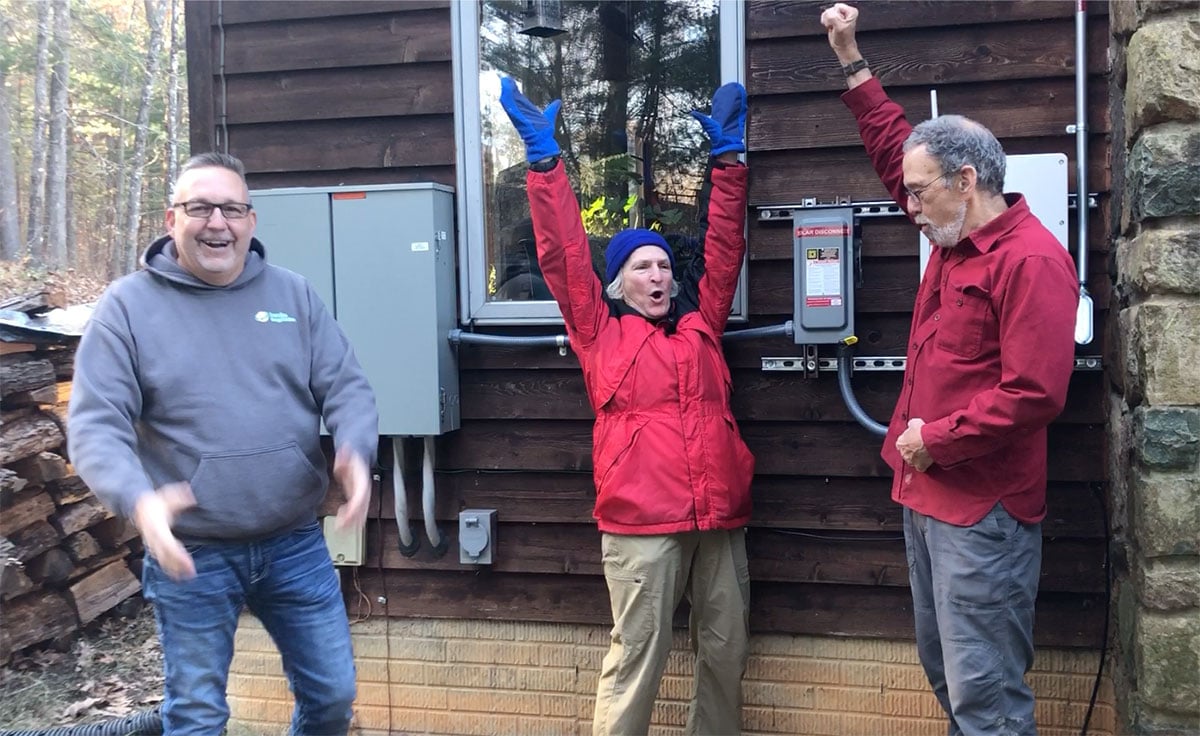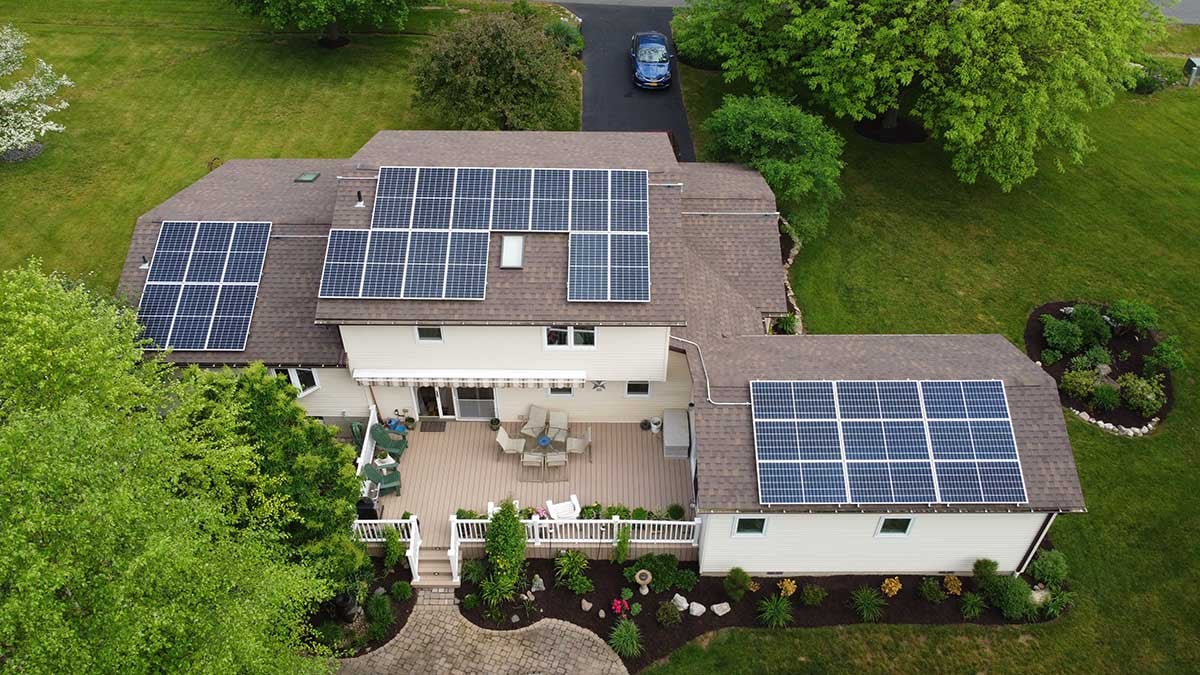
Video Guide to Home Solar
Going solar doesn't need to be difficult. Let this comprehensive guide to solar panels for homes pave the way for a successful solar installation.
Larry and Warren get into the nitty-gritty in this video, covering everything a homeowner needs to know before going solar - from the cost and incentives, to the various types of solar panels and inverters, and so much more.
Use this video to embark on your solar journey with confidence and clarity.
Jump ahead to the content in this video you're most interested in:
Are you considering going solar for your home? Then this video is for you. We've taken everything we've learned from installing over 2,000 solar systems and comprised it in this comprehensive guide to help you achieve a successful solar installation. Before we get into it, if you'd like to download this guide in a PDF, we'll leave a link in the description below. So Larry, let's jump into and talk about the basics. First of all, how does the solar system work?
Larry (00:32):
So solar is really cool. I mean, what's cooler than getting electricity from the sun?
Warren (00:37):
Right.
Larry (00:38):
The sun is going to be there, you know it's going to be there. But at a very basic level, you have several components. You have your solar panel that collects the light, you might say, I don't know if collect is the right word, but it's there to collect the light and then create DC electricity that goes to your inverter. Your inverter converts that to AC, which you can use in your home or business. And then you typically have an AC distribution panel that the power goes through. From there, the power can go to your loads, and if you don't need it, then it goes back out to your utility meter and your utility meter can spin both ways, which we'll talk about next.
Warren (01:14):
Right. Which leads us to net metering and meter aggregation, and then in some areas there's net billing or other mechanisms such as New York, the Value Stack. We'll get into that a little bit, but let's start off with talking about just net metering as we know it today.
Larry (01:31):
So at a very basic level, net metering allows a customer to buy power from the utility at a rate and then sell power back to the utility at the same rate. So if you need power during the day, you can pull it in at that rate. If you're producing more than you're using, you can push power back out and get a credit at that same rate for later use, and that credit can carry over to the next month. It can even, in some cases, carry over to the next year. So that's the basic, at a very basic level, that's net metering.
Warren (02:03):
So that's an even exchange. You send one kilowatt-hour to the grid if you're not using it, and when you need it, you take one back, you get one kilowatt-hour back, and essentially you're using the grid as your storage. Let's talk a little bit about aggregate metering or meter aggregation.
Larry (02:21):
So meter aggregation is another level where you combine multiple meters together. So let's say you're a farm, you've got a meter at your house, you've got a meter at your barn, maybe you have a meter at a chicken house, and you're saying, "Well, I just want to install one solar array to provide power for everything." So you have two options. You can physically combine all those meters. It's going to be a lot of work, a lot of electrical costs, wiring costs. So if we can stay away from that, we will. And the way you can stay away from that in some utilities is you can build a system on one meter, and then take the kilowatt-hour credits from that meter and apply them to your other satellite meters as long as they're within a mile or two. Not every utility allows this, not every state allows this, but that's the basics of virtual meter aggregation.
Warren (03:08):
Yeah. And there are different rules and regulations on how it works and who can do it in each jurisdiction. Now, Larry, let's talk about solar renewable energy credits or SRECs. What are they and how do they work?
Larry (03:20):
So sometimes people get confused here because the SREC is different than your electric savings, and it's also different than pushing power back out to the utility. That's the basic benefit of your kilowatt-hours, you either use it or you send it back to the utility and get a credit for it. Separate from that is the solar renewable energy credit, which is a credit for producing power from solar. It's basically a green energy credit, you can think of it in that way. So every 1,000 kilowatt-hours you produce, you get one of these credits and utilities are required to buy these credits. Most states require utilities to buy these credits to show they're producing a certain percentage of their power from solar. Instead of going out and building big systems, they'll buy credits from solar producers. That's something that we sell. We aggregate large amounts of credits from our systems and we sell it to aggregators who then sell it to utility.
Warren (04:17):
And essentially the customer, you, who install solar on your home, you'll get a check for those energy credits as a source of income.
Larry (04:24):
Right.
Warren (04:24):
All right, super. So now let's talk about how much sun do you need on your house in order to make it worthwhile for solar?
Larry (04:32):
This is the whole trick with solars, you got to have sun. You can't produce electricity without sunlight, you got to have the sunlight. It doesn't come from heat, it comes from the actual direct sunlight. So the more sunlight that hit your roof, the better. And obviously the enemy of that is going to be shade is the big enemy, trees, any other obstructions that you might have, maybe it's another large building or if you're on a farm, maybe it's a silo or a grain bin or something like that. But then there's other things to consider like, what about snow? What about soiling over time? Are you on a dusty farm where there's going to be dust come on your panels that's not going to be washed off over time? We take into account all these different factors and we have a production guarantee. So we look at shade for your particular situation. We look at the tot of your roof, the orientation of your roof. Are you facing south? Are you facing east, west, north? We take that on into consideration and put that into a production guarantee for each particular system.
Warren (05:31):
Super. So in summary, when you're thinking about the basics, the way solar works is that the solar panels are sitting on your roof. They capture the sunlight and they turn that sunlight into energy, into direct current energy, which then flows to the inverter, which is a component that would either be on your roof close to the panels or mounted somewhere in your garage or on a wall that changes, that converts that electricity from DC to AC, which you can use in your house. What you don't use on a sunny day would be pushed back onto the grid, and that triggers the net metering mechanism. So if you're sending electricity to the grid, you can take it back at the same exchange rate, one kilowatt-hour you send, you receive one back. It's not available net metering in all areas. Some areas have net billing, which is slightly different or a different way for compensating you for solar, but that's the basics on how solar works.
(06:26):
When it comes to meter aggregating, that allows you to take multiple meters and have one solar system, the energy from that system virtually apply the credits to multiple meters, and that's only available in certain areas and has different rules and regulations associated within in each area. And then the solar renewable energy credits different from net metering has nothing to do with how much electricity you use or don't use or how much you send to the grid. All it matters is how much renewable energy you create. And every time you create a thousand kilowatt-hours, you earn an energy credit and that energy credit's valuable. And at Paradise Energy Solutions, we can sell it for you on your behalf or you could do it on your own, but it is a source of income that you'll get just from producing renewable energy credits. And then finally, of course, you need to have the solar panels where the sun shines.
(07:19):
And so if you're completely shaded, solar probably doesn't make sense for you, but we'd love to come out and do a shade analysis. If you're wondering whether or not you need you'd be eligible for solar, we can give you guidance on that. But you do need to have a fair amount of sun, at least between 10:00 AM and 2:00 or 3:00 PM in the afternoon in order for it to be worthwhile. All right, Larry, let's talk about pricing and payback now. I know everybody wonders how solar is so expensive or how much does solar cost, how much does it cost?
Larry (07:50):
So there's a number of factors first that we need to think about that are going to affect that cost, because we can talk about basic costs and we will in a minute. But let's talk about some of the factors that affect the cost. Obviously the size of your system, how much is your electric bill? How many panels do you need? Do you have a lot of shade, which means you need more panels? How does that all fit together? Secondly, is it going to be a micro-inverter system, a string inverter system, an optimizer system to give you more value? Is it going to be a ground mount, a roof mount, some of those types of things? And then, also what incentives are available? That doesn't affect the upfront cost, but it'll affect the bottom line number.
Warren (08:29):
Sure. But the point here is that it's really unique and specific for a particular homeowner. It's not a cookie cutter system that one size fits all. It's really unique to your home and your situation and how much electricity you use at home.
Larry (08:47):
Right. Right. Now we can talk about some basic numbers just to help people understand what they're looking at. So if your electric bill is, let's say $60 a month, you're typically going to be looking at about 26 to $27,000. Now, obviously we have these factors, so it could be different than that, but that's kind of the price range that you're looking at. If you're at, let's double that, $120 a month, you're probably looking at maybe around 39,000. And then if you're at $180 a month electric bill, you're probably looking somewhere in the mid 50s as far as cost. But now remember, there's incentives that come off of that. And also remember that as a homeowner, you're going to pay 30, 50, $60,000 plus over the next 30 years for electricity. And a lot of our systems have 25 or 30 year panel warranties, and so they should be lasting longer than that.
Warren (09:45):
That's a really important point when you look at the cost of solar in the... It is an expensive investment upfront, but when you compare the 30-year cost to versus paying your utility or going solar, almost in every instance we see that solar is by far a little less expensive route to go. So Larry, let's talk about the incentives. What incentives are available for homeowners?
Larry (10:07):
So the main one is the investment tax credit or we call it the ITC. It's a tax credit, not a grant. It's a tax credit from the federal government against your federal income taxes, and it's 30%. So you can take your total system cost times 30%, and that's the tax credit that you're eligible for, and you simply get that when you file for your taxes. Then there's other state incentives. Maryland has a state grant. New York has a state grant, New York also has a state tax credit. So states can have grants, which is cash that you'll get, or they can have tax credits against income taxes for that state. And there's other, sometimes counties will have an incentive that's a little bit more rare or unusual, maybe utilities will in some very rare cases. So those are the main two. And then of course you also have the SRECs, like we talked about, the renewable energy credits for the power that you're producing.
Warren (11:05):
Right. So it's the ITC, 30% of the cost of the system. It's a dollar for dollar tax credit that's back in your pocket. The SRECs, which you'll earn for producing the income that you do, and then any state or local incentives there. Let's talk about now the differences between owning a solar system versus maybe leasing a solar system, and then we'll talk about how to approach either one of those.
Larry (11:31):
So yeah, there's a couple options there. Ownership is where you own the project, you get the incentives, you pay for it upfront, you pay for the maintenance, but then you get all the benefits over 30 years.
Warren (11:43):
Yep.
Larry (11:45):
Versus leasing where you don't have to pay for it upfront and you don't have to pay for the maintenance, but you have a monthly payment for the life of the lease. Some leases have escalators, so watch out for that. Check your leasing terms and make sure you know what the lease payments are going to be over the life of the system. But then you don't have the upfront, you don't have the maintenance, but then you don't get the incentives or the benefits either. Now, there's a third option, I'll just touch on briefly, and that's PPAs. So a lease is like you're going to have that monthly payment no matter what your system produces. A PPA is where you actually pay for every kilowatt-hour that the system produces. So if it doesn't produce what the company said it would, you don't have to pay as much that month if it doesn't produce what the company said it would. So those are the three basic options, ownership, lease and PPA, but you can really put them in two buckets, owning versus not owning.
Warren (12:43):
So if somebody is looking to own the system, they can either pay for it upfront with cash if they have that money available, or they could seek out financing. And how does that work? How did they approach that?
Larry (12:57):
So there are some loans out there specifically for solar. Now, of course, we recommend cash if people can, and we would also recommend a lower interest home equity line of credit or something like that if possible. Something with your local bank is the most ideal. If you don't have that, we can do financing from banks specific to solar. Now, typically there's going to be a higher dealer fee, so you're going to pay a higher cost for the system upfront in order to access that financing. But oftentimes the interest rates are pretty reasonable. But then the way that works, it's just like a mortgage.
(13:30):
So it's your system, you own it as long as you make those payments. But now you're also responsible for maintenance. And if something goes wrong, that's on you. Now, one other thing I didn't mention, one other benefit of ownership is that the value of your home goes up. If you lease it or do a PPA, the value of your home doesn't go up because it's just a liability. It's not an asset. If you own it, it's an asset. If you don't own it, ends up being just a liability.
Warren (13:59):
Absolutely. All right. So let's talk about maintenance. What type of ongoing maintenance is there and what part of that maintenance is the responsibility of the homeowner?
Larry (14:10):
So again, that's going to depend who owns it, but let's say, case in point, let's say that the customer owns the system, which is the ideal situation. In most cases, there's going to be very little maintenance. Your solar panels should be pretty good. You might have an issue with an optimizer, a microinverter, or your inverter here and there. We do have issues from time to time. But if it's installed properly by a qualified contractor, you should be pretty good for the long term. Now, one thing I'll note here is that at Paradise we have our 10, 10, 10. So that puts all the maintenance back on us for the first 10 years outside of a fire or a tornado or something like that, that's highly unusual, but all the typical maintenance would fall back on us and on the manufacturer with our 10, 10, 10.
Warren (14:59):
Right. And I know we talked about this briefly about property taxes and it adding value, and becoming a liability if you don't own the system, if it's a PPA or a lease versus if you own it. What does that typically do to the value of your home and then as well as the property taxes associated with that?
Larry (15:23):
Yeah, it's a good question. So again, if you own it, your home value should go up.
Warren (15:27):
Correct.
Larry (15:27):
Because if I'm comparing your house to a house across the street, same house, one has an electric bill, one doesn't, I'm going to pay more for the one that doesn't have the electric bill. So that should add some value. But then the question comes up, what about my property taxes, will that go up? So at this point, 32 states don't allow solar to add to the property taxes of the home. So 32 states protect you from that. If you're not in one of those 32 states, it's possible that your property taxes will go up, you definitely want to check into that. But it's probably unlikely because solar, yes, you're attaching it to your home, but technically it's removable. So it's not permanent in that sense, and you may be able to avoid a property tax increase.
Warren (16:15):
Now, let's talk about system design in some considerations with the first one being whether or not you want to be tied to the grid or off grid?
Larry (16:24):
Yeah, that's definitely the biggest consideration because being off grid is just so much more expensive than being grid-tied. And the reason for that is the grid acts as your battery, as your storage. You produce extra, goes out to the grid, you need power, you pull off the grid, like we talked about with net metering. So that's why, I mean, the vast majority, nearly all of our customers go grid-tied just makes so much sense from a cost perspective. Now, the downside to grid-tied is when the power's out, you're offline, your inverters are offline, they have to shut down when the power's out, unless you have a battery or some kind of backup. Or unless you use something like the Enphase IQ8, that new technology that allows you to run some of your loads, just a very small portion of your loads during a grid outage, as long as you have sunlight. But in most cases with our systems, the system's going to be down. So that's the nice part with off-grid is that you're still running when the grid is down, it's just a lot more expensive because you need all that battery storage.
Warren (17:22):
So then, let's talk about the next consideration, which is whether or not to put the solar on your roof or maybe put it on your ground, which is better. Or if you're a business maybe on a carport structure.
Larry (17:34):
So you want to look at the space that you have. A roof mount can work really well as long as you have the appropriate orientation. Are you facing south? What's your tilt like? Is it fairly easy to access? And then, do you get a lot of sun or is it shaded? So that's the big things to think about with a roof mount. The cool part about a ground mount is you can put it wherever. You can face it South, you can avoid shade, but then with a ground mount, you have higher costs because now you have to build the structure for the ground mount. You've got to run a wire underground back to the house or back to your business.
(18:05):
Carports can be really cool because they're just utilizing space that is used anyway. I mean, your parking lot, but again, they're a lot more expensive than even a ground mount. So those are some of the considerations. The ground mount's nice because you don't have to worry about the extra weight load on your building or anything like that. The roof mount is nice because you've got your yard freed up or any other space you want for business expansion. Those are some of the considerations.
Warren (18:34):
All right, Larry. So now we know that we've made the decision that we're going to be grid-tied. We've decided that where we're going to put the solar. How do we know which solar panels to pick?
Larry (18:45):
Yeah. So we do a lot of that legwork for our customers which brands, there's so many options out there. We really narrow that down and help our customers make great decisions with that. But there's four basic things that I want to go over on the technology side. One is the typical monocrystalline that's been around for a while versus the newer bifacial module, which is more recent. The monocrystalline typical module, you're getting power off the top just like usual. The bifacial is cool, because now you can get power from the backside as well, which is really nice, especially at a ground mount. Now the bifacial is a small cost premium and it's quite a bit heavier, so maybe not quite as good of an idea on a roof mount. So that's one consideration to think about. Another one is the color of the module. So the typical module is a silver frame, maybe like a dark cell and a white back sheet.
(19:38):
But if you're really concerned about aesthetics and the looks of your system, you can go black frame, black cell, black back sheet, have a really sleek look. Again, the black is going to be a little bit more expensive than the silver framed. Another consideration is panel size. Do you go with a smaller panel, typical for residential? Do you go with a bigger panel that's more typical for a commercial or utility scale? What about the weight? Some of those types of considerations. And then finally, what's the efficiency of the panel? Higher efficiency panels can put out more power from a smaller space, but then they're more expensive. So if you have plenty of roof space, don't worry about efficiency, module efficiency as much. Go with a more cost-effective module. If you have limited roof space, you might want to consider the higher efficiency. So those are the four basic things to think about with modules.
Warren (20:29):
Yeah. So then what about inverters?
Larry (20:33):
So inverters and there's three basic types. You have your string inverter, you have your microinverter, and then you have your optimizer. Your string inverter, it's like one box in the wall. It converts DC to AC and it does the maximum power point tracking. So it's trying to pull all the power it can out of each string that it's connected to. Your microinverter is going to be more expensive. But then you've got each panel has its own inverter, again, converting AC to DC on the roof under the module or on the ground mount. But then it's also pulling the maximum amount of power out of each panel. So if you're shaded, you have different levels of soiling, your panels are putting out different amounts of power for whatever reason, you're pulling the max out of each panel.
(21:18):
And optimizer then splits the two functions up. Boxing the wall, converting DC to AC, optimizer under the roof, under your panel, maximum power point tracking on the roof, and it's kind of between. So string inverter is cheapest, microinverter is the most expensive, optimizer in between. And then there's a monitoring piece, with an optimizer or a micro inverter you can monitor per panel, inverter may be monitoring at the string level.
Warren (21:44):
Are there any maintenance requirements with inverters?
Larry (21:48):
So that's another consideration, when you have your one string inverter on the wall, if it needs to be replaced, much easier to replace. If you have an optimizer or microinverter up on the roof, under your panels, a little more difficult to get to and it's out in the sun, the wind and the rain a little bit more, maybe a little more challenging from an electronics perspective. Again, maintenance is going to be low typically on these systems, but that's definitely a consideration.
Warren (22:15):
And one thing to consider is it's not really maintenance, but to make sure you have an internet connection to your inverter so that it can be monitored online.
Larry (22:24):
Yeah. Our team can see that, our maintenance team and they can proactively take care of issues.
Warren (22:31):
All right, Larry, so now let's talk about the installation process. What are the steps involved to get a system installed?
Larry (22:38):
So the very first step is a site visit.
Warren (22:40):
Yeah.
Larry (22:40):
So we'll come out on site, we'll evaluate what you have, your electric service, your transformer size. We'll look at your house, your farm, your business. We'll look at roof versus ground. Consider some of the options. Do you have a budget? What does that look like? What kind of shading is on your roof at your ground mount location? And there's a lot of options, but what we try to do with the initial site visit is narrow it down to a few options that really make sense for you and your situation.
Warren (23:11):
Great. And then once we have that component dialed in, we have all the information we need from the site visit, what's the next step in the process?
Larry (23:19):
So from that information, we will develop a detailed quote, and that quote will have, how many solar panels, what solar panel, quantity of inverters, which inverters are we choosing? What's our projected production based on your site, your specific site conditions? What's the cost? What's the incentives? What's the payback? The ROI? Lots of information, and you can take that and you can look at what's important to you. Is it the upfront cost? Is it the incentives? Is it the equipment? You can look at whatever's most important to you at that point.
Warren (23:55):
So from that detailed quote, you really have all the information you need as an informed consumer to make a decision on whether or not solar makes sense for you. And assuming it does, where do you go from there?
Larry (24:08):
So next, it's a signed contract. So sign the contract that you feel fits your needs the best. Maybe we've looked at a couple of options, roof versus ground, sign the one that fits your need the best, and then we're off to the races at that point.
Warren (24:21):
What does that mean, we're off to the races? We take the signed contract and what do we do?
Larry (24:25):
So we take the signed contract, we do drawings, we do electrical drawings. We'll do a layout drawing, and then we'll submit for the application. So there's a fairly complex paperwork process that goes into each project. We handle that all in-house from start to finish. We'll submit the applications to the utility, we'll submit it to the permanent authority. We'll take care of the grant applications. Of course, we may come back for more paperwork, signed documents, that type of thing. But we'll take care of all of those applications for you.
Warren (24:58):
Great. So at this point, now we have developed the system internally. We've applied for the permits, we've applied for whatever grants. What happens next?
Larry (25:08):
So next construction begins. Once we have a shovel ready project, we begin construction. We'll work on scheduling it with you, getting on our calendar, making sure we have the proper equipment, and then we'll build the system.
Warren (25:20):
And then the system's completed, and what happens?
Larry (25:23):
Now you have free electricity. Once you've paid for the system, you get your grants, you get approval to operate from the utility, and now the rest is yours.
Warren (25:32):
So those are the six easy steps to getting to free electricity. You just request a custom site visit. We'll come out, take a look at your site, make sure we're building it exactly for you and your location. We'll take that information, develop a proposal for you. If the proposal makes sense, you sign the contract, we begin the work on our end. We begin permitting and designing the system. Once that's in place, we come out, we install it, we commission the system, we turn it on, and you have free electricity. So now let's talk, Larry, about the next step in the process is how do you choose the right installer?
Larry (26:09):
So this is a very important thing to think about because this is not a $5,000 investment. This might be a $30,000 investment or a $300,000 investment or even a $3 million investment. So you want to make sure that you're working with an installer that knows the location that you're in. Are they familiar with the permitting authorities? Are they familiar with the utilities? Are they familiar with the grant application processes? Have they done it before? Have they done a system that size before or that type before? Have they done a battery system as large as the one that you're looking at? Those are some of the things to think about.
(26:45):
How long have they been in business? Have they been around for a decade or did they just start yesterday? Are they financially stable? Will they be around to honor their warranties 10 years down the road? And then of course, you also want to think about, what are their customers saying? People that have worked with them? What do their reviews look like? What's their website look like? Do they work professionally? Do they know what they're talking about? Compare what they say with what the rest of the industry is saying and make sure that they understand what they're talking about.
Warren (27:18):
Great. So once you've decided and you've picked a reputable installer, and maybe you're looking at a couple of different reputable installers, how do you evaluate their solar proposal? What are you looking for in that proposal?
Larry (27:33):
A couple of things that I would suggest initially is have they mentioned which products they're going to use and the manufacturers?
Warren (27:42):
Okay.
Larry (27:44):
Do they know the quantities and the manufacturers? Do they just say an estimated system size? Is their production, does it make sense versus the system size? Have they talked about shade? Have they taken that into consideration? What are their warranties like? What's their workmanship warranty like? What are the things that can void their workmanship warranty? Do they have a production guarantee? What's that look like and what can void their production guarantee? Those are some of the basic things to look for.
Warren (28:09):
All right, Larry, so we've talked about quite a bit of good information here that's in this guide. Let's sum it up with some of the pros and cons about going solar. Let's start off with the benefits. What are the key benefits of going solar?
Larry (28:23):
Yeah, so there's always trade-offs to consider. A number of benefits that we've talked about is the electric savings and the SREC income. That's the main reason typically why people go solar.
Warren (28:33):
And the tax credit.
Larry (28:33):
And the tax credit.
Warren (28:34):
Yeah.
Larry (28:34):
The tax savings, the other incentives, those are some of the benefits of going solar. And then of course, the green aspect. It's better for the environment to use green energy from solar, from the sun than it is to use something like coal. And then of course, you're going to have a system that's very low maintenance and should be around for a long time.
Warren (28:55):
Right. Yep. And so what are some of the downsides?
Larry (29:00):
Some of the downsides would include when the grid goes down, your system's also going to go down. Unless you have battery storage, your system's going to be down when the grid goes down. Another one would be if it's a ground mount, it's going to take up some of your yard space and you think about how that's going to fit and how that comes together. And then of course, installing solar is going to take up front capital. You're going to need to find a way to get that cash up front, whether it's a loan or some other way to get that capital. And then finally, if the sun doesn't shine, your system doesn't produce.
Warren (29:35):
That's right.
Larry (29:35):
So I guess one of the worst cons is that the sun stops shining, which shouldn't be an issue.
Warren (29:40):
Hopefully not. Hopefully not. Don't forget if you'd like a PDF copy of the guide, we'll have a link to that in the description below. Also, note that we have one for homeowners, one for farmers, and one for businesses. So you'll be able to download the guide that's specific to you. Also, if you'd liked any of the topics and you'd like to take a deeper dive into anything we discussed today, we have videos on all these different topics on our YouTube channel. Please, if you enjoyed the video, leave a comment below. If you didn't like the video, leave a comment as well but let us know why. And we hope you found this valuable. Thanks for watching.
Tools & Resources
BLOGS
CALCULATOR
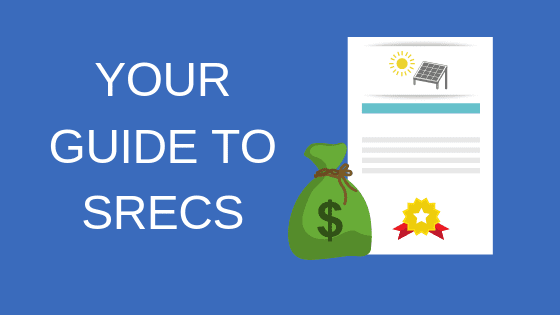
Guide to SRECs
One of the lesser-known benefits of owning a solar energy system is Solar Renewable Energy Credits (SRECs). SRECs may not be a household name, but they can drastically improve the financial returns of owning a solar system, which means putting more money in your pocket.
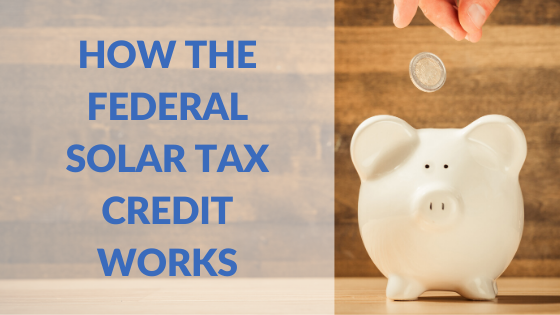
Guide to the Solar Tax Credit
For years, the Solar Investment Tax Credit (ITC) has been a valuable incentive for individuals and businesses interested in investing in solar energy. However, with the passing of the Inflation Reduction Act (IRA) in August 2022, the ITC has received a significant upgrade.
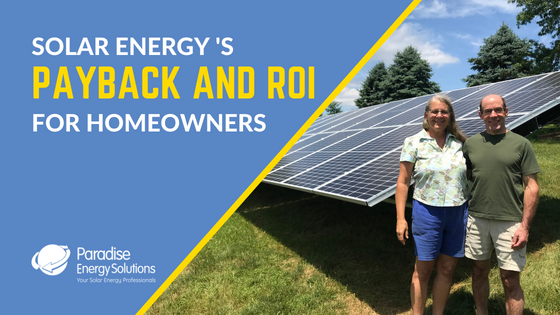
Payback and ROI of Solar Energy for Homeowners
With cost-saving incentives, rising electricity prices, and varying installation costs, it can be hard to quantify the specifics of this investment without reaching out to a solar installer for a quote. But to help give you a ballpark idea of what to expect, we created this blog.
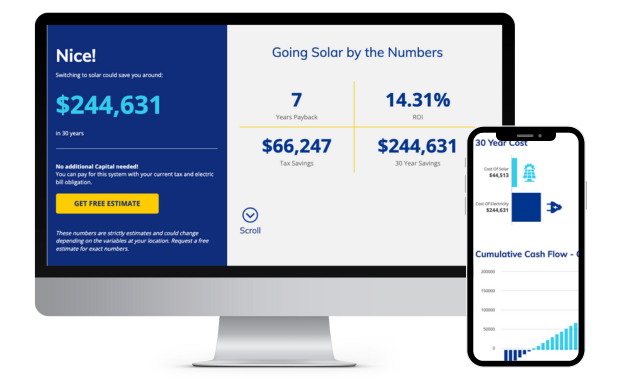
Solar Savings Calculator
Use our solar calculator to see how solar can help you. You can instantly get an estimate of ROI and payback, expected tax savings, 30-year cash flow, and how the cost of solar compares to if you continued to pay your utility company.
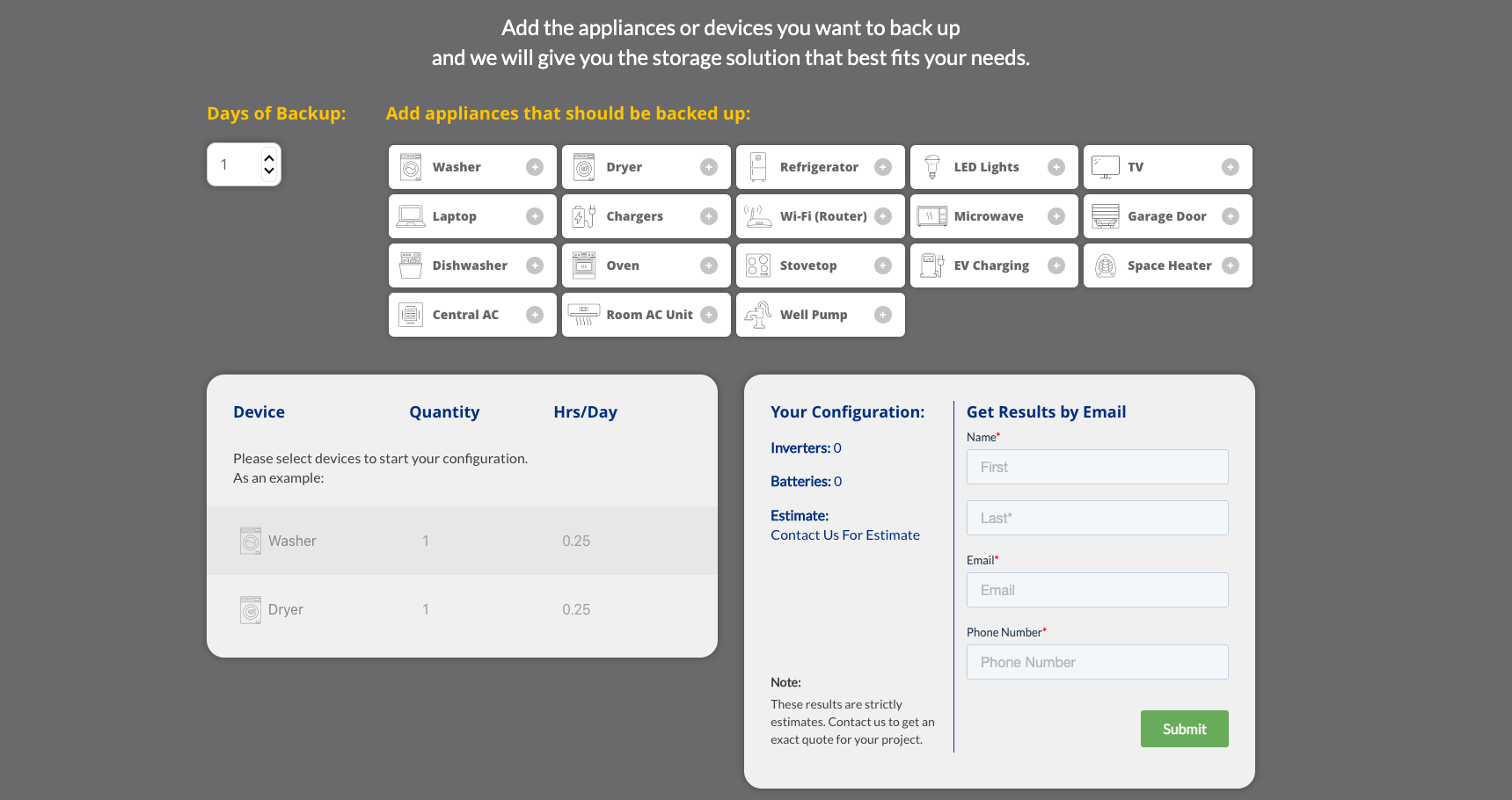
Battery Back-Up Calculator
Try out our Storage Calculator to estimate the amount of backup power you'll need in an outage based on your unique appliance and power needs to see what your configuration could cost to implement.

